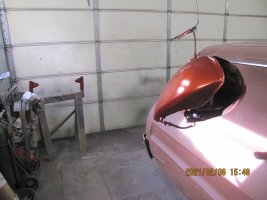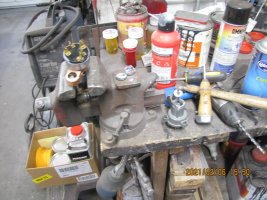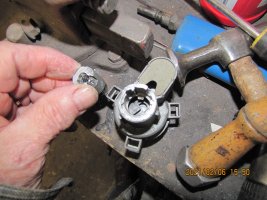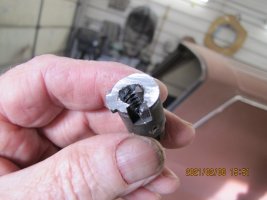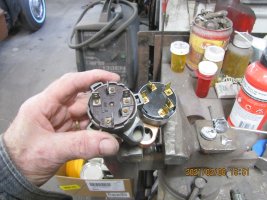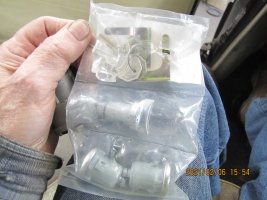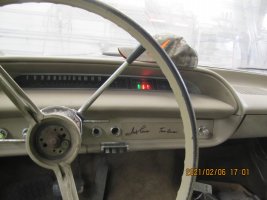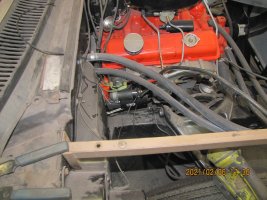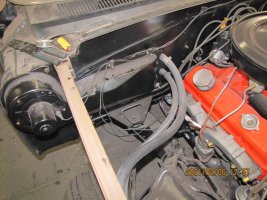the Pinner either did not come with a key or I lost it the first day. so now what. I could not remember if 64 was a A,B set or not. but late one night looking at parts site, I found a set for a 64 Elcomeno both door locks the glove box(needed) and the switch lock with a new switch. one key, great score. now that we have it in the work stall instead of the I was going to get to place it. lets put it in. got coned int doing some more Motorcycle parts again. so between working on then, I got started changing the switch. first was get the old one out. I chopped the ears off so that we could get the bezel off. and removed it. then started comparing the switches. only GM would make different switches in the same year. the pins we in the same location, all most. off just enough that the harness would not clip on. two choices now. cut wires and do one at a time or get the old lock out and hope the original was good. working under a dash of a 60s car is not fun, lets get the old lock out. a number of ways to do it but the only one open to me at the time was drill it out. so drill we did. the key is to use a big enough bit to cut into the brass pins so they fall out and you can release the bar. with out of course destroy the switch is a good thing.. we were successful in that. but now will it work. put it back in the car and using the screw driver key to try it. once I found were the power wire hooked up to the harness we got lights. now the start . found were the people that remove the engine cut the wires going to the starter. so spliced in the start wire for the distributor and the trip wire. put the lock in the switch and turned it to start. it scared me to death when she fired on the first roll. remember the key to not getting over whelmed in a project is one thing at a time and one thing every time you can. our next coal is to get the under hood wiring harness completed and in place on the raidator support we did last year. you might be able to fallow threw on the pictures here
You are using an out of date browser. It may not display this or other websites correctly.
You should upgrade or use an alternative browser.
You should upgrade or use an alternative browser.
how to butcher a switch
- Thread starter John ED Renstrom
- Start date
The key for that car is a B10 for the ignition and doors. Had you told me that you didn't have a key for the car, I could have sent you my master key set that would have released the cylinder without damage. On the side of the cylinder, there is a key number stamped into the barrel. With that number, you can get the proper key cut by a key clipper. It will be a lot easier to get the car running, if you purchase a reproduction engine wire harness and replace the old with new. This is what I did with my 1962 Chevrolet, since the old wires had been chopped up, and some of the wires showed deterioation from age. If the dash wiring is also damaged, it is also available as a reproduction part. The company that makes all these wiring harnesses is located in New Jersey, and they are manufactured using all the original General Motors wiring diagrams. You can find them at https://www.americanautowire.com/. I suggest that you call them for pricing to get the correct parts, since the catalog is so extensive. .
I have two sets of "try out" keys, and if one set doesn't work, then the other one will. A few years ago, Danny Ryder bought an old Buick in Massachusetts, and we got together for dinner. He told me that the car didn't come with any keys, I brought along my set of master keys, and it took less than 5 minutes to find one that would work. I took that key off of the ring, and he took it with him, and sent it back after he had a copy made.
I have a Curtis Model 15 key clipper to make the keys, however, it needs an adjustment since it isn't cutting properly. I misplaced my manual that tells how to make the adjustments, and making you a key that will work, presently isn't an option. There is a locksmith in the club that I know can help you if you want to go that route.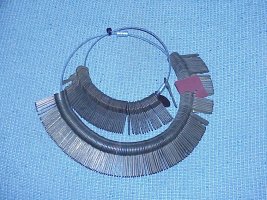
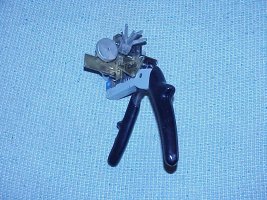
I have two sets of "try out" keys, and if one set doesn't work, then the other one will. A few years ago, Danny Ryder bought an old Buick in Massachusetts, and we got together for dinner. He told me that the car didn't come with any keys, I brought along my set of master keys, and it took less than 5 minutes to find one that would work. I took that key off of the ring, and he took it with him, and sent it back after he had a copy made.
I have a Curtis Model 15 key clipper to make the keys, however, it needs an adjustment since it isn't cutting properly. I misplaced my manual that tells how to make the adjustments, and making you a key that will work, presently isn't an option. There is a locksmith in the club that I know can help you if you want to go that route.


Last edited:
As i said its done now. I have now got two new keys for the switchs, doors and glove box. The only with s cut are the two off the starter. The main power wire is connected to the power side of the horn relay on this one. the horn relay is loose,so i had to try both of them to find the one going inside. So far the one thing the mice have not ate up on the car is wiring. The only thing i may need to do is replace the temperature unit this has the green and red lights. If i remember the truck had a gage.
If the car has the red and green lights, it would be best to get a NOS switch, since the auto parts store units don't last 3 months. I kept getting replacements from Advance under their warrantee, but changing them was a pain. Bought a NOS Delco unit on eBay, and it has worked properly ever since. Possibly what they are selling today is of a better quality than what they were selling 5 or 6 years ago.
Peter Grave - Deceased - 1938 - 2022
PCS Member
Back when I got into the car business as a growing up kid GM and their keys were a joke. My 41 Pontiac key number was 8723 and my best friends Moms Bucick Roadmaster used the same 8723 key. Every original GM key had the key number stamped in the key the buyer was to knock it out few did. Thus if car was in for service etc easy to write key number down go to a GM dealer give the parts dept. the number and presto for usually $3.00 you had a key to that car.. Car thieves using the better mouse trap idea would buy the Curtis key cutter as Paul showed walk down a street see a GM car they wanted take vice grips go to the outside door lock twist it round till it came go to their car with the key cutter read the key number again stamped in the lock cut a key go back to the car open the other door like they owned it start and drive away. Along in 1975 theft was so rampant they go the idea along with the steering column lock to make the ignition key fit only the ignition lock not the doors door lock and trunk key became the same OH and they stopped stamping the numbers in the locks. The car thieves responded to this by simply smashing the steering column pulling the lock out using a screwdriver to turn the switch and go. The funniest one was in 1962 I bought a brand new (46 miles) Corvette from Motors Insurance had been stolen from Chevrolet dealers with the twist the door lock method and motor and transmission removed. Didn't fix it sold it to a drag racer who put a much modified motor and trans mission in.
The change to the door and trunk key not fitting the ignition lock started in 1967 with the A & B keys. They changed the keyway each year after that, so 1968 had C & D keyways that were different than previous keyways. Using that method, a key from one year wouldn't fit into the lock of another year. They also changed the cut codes each year to further the difficulty of reproducing keys by code. GM was still stamping key numbers into the door locks in 1969. Here is one that I just happen to have on my desk.
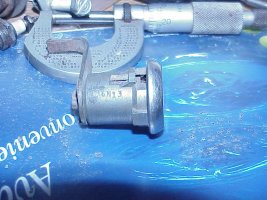
The keys were usually grouped in lettered pairs, which include: (A, B), (C, D), (E, H) and (J, K). Stock GM vehicles will use one of these group of keys, and which group depends on the year the vehicle was manufactured.

Peter Grave - Deceased - 1938 - 2022
PCS Member
See what happens when you get old and rusty. I should have remembered as Curtis kept me busy buying key blanks back then with the ongoing changes. Now I gotta try to remember when they stopped numbering door locks.
See what happens when you get old and rusty. I should have remembered as Curtis kept me busy buying key blanks back then with the ongoing changes. Now I gotta try to remember when they stopped numbering door locks.
When you get old and crusty, it really doesn't matter much what you remember or don't remember. It is staying above ground that is the most important part of your day.

Right now for e its getting to the bathroom in time.
1974 was the first year they stopped numbering the cylinders. Also the first year the ignition cylinder was keyed differently than the door cylinder. And as a P.S. if your door (or trunk) cylinder stainless steel cap is roll crimped around the cylinder case it is either a OEM or a precoded replacement cylinder, if it has four tabs bent over to retain it to the case 90 degrees apart it is a GM service replacement part that was coded by the dealership.See what happens when you get old and rusty. I should have remembered as Curtis kept me busy buying key blanks back then with the ongoing changes. Now I gotta try to remember when they stopped numbering door locks.
One of the first things I was taught in dealerships was to read keys without using one of the Curtis decoders. Second thing was how to code blank lock cylinders, that and how to deconstruct and recode lock cylinders.
One other tip, mainly for 1978 cars. The column ignition lock cylinders, two designs. First uses a spring tension bar to lock it into place in the lock bowl, should be a diecast metal lock bowl. Second design, two Phillips head screws retain the lock cylinder to the lock bowl, those are plastic lock housings. The second design will install in the first design housing but no way to retain the cylinder to the housing.
That whole thing with the GM keys worked out well for me. I had to take my (at the time) '64 Superior Pontiac to a show in Philadelphia. I loaded it on the trailer, and put the keys in my coat pocket. Then it got warmer. I switched coats and left for Philly. When I got there, no keys. We found a local locksmith who had the GM keys (all in a box). I started trying one at a time. After about 20 minutes, I found one that worked, and he made a copy, and we were good to go!
In this case i needed the glove box latch and lock anyway. So when i found a one set for a El Cameo i went for it.


